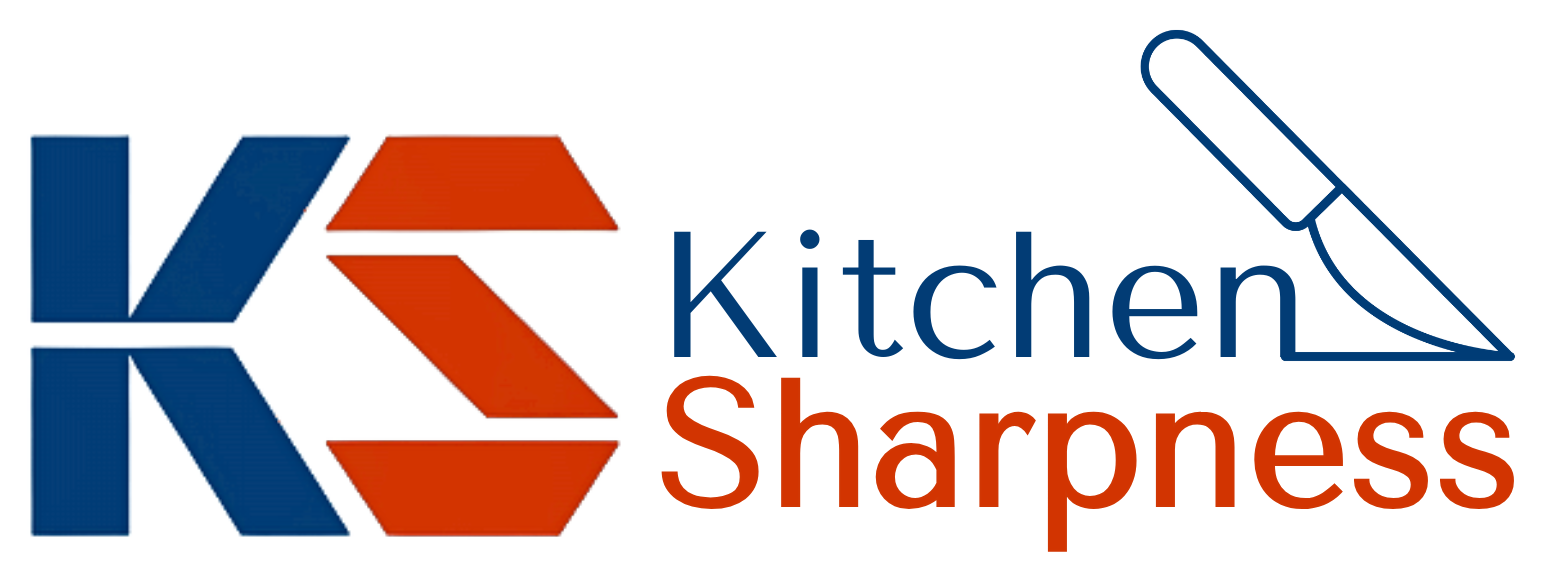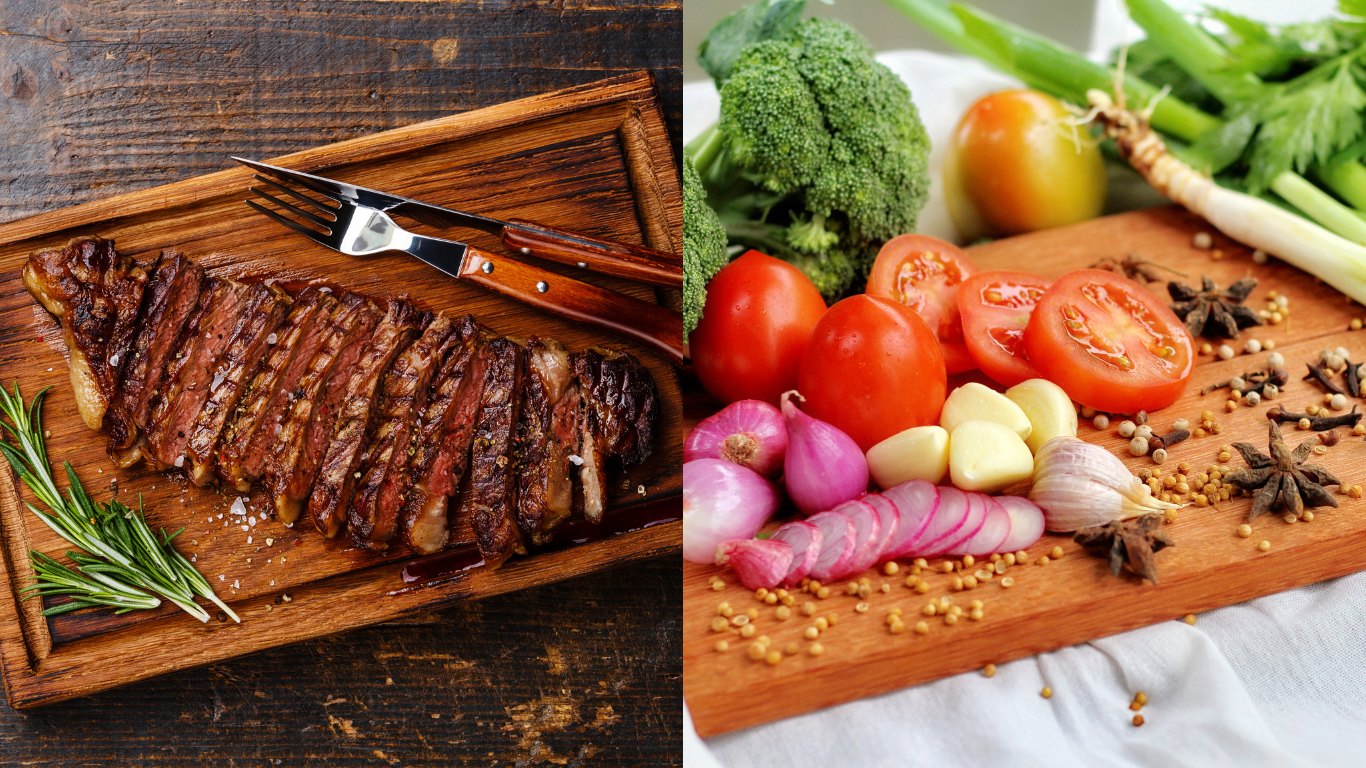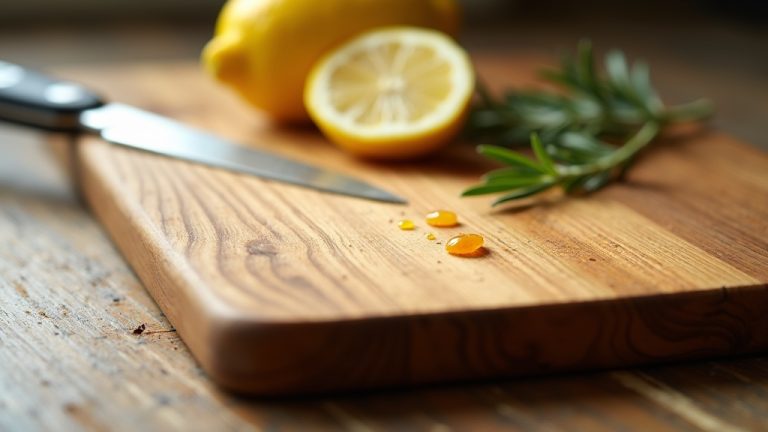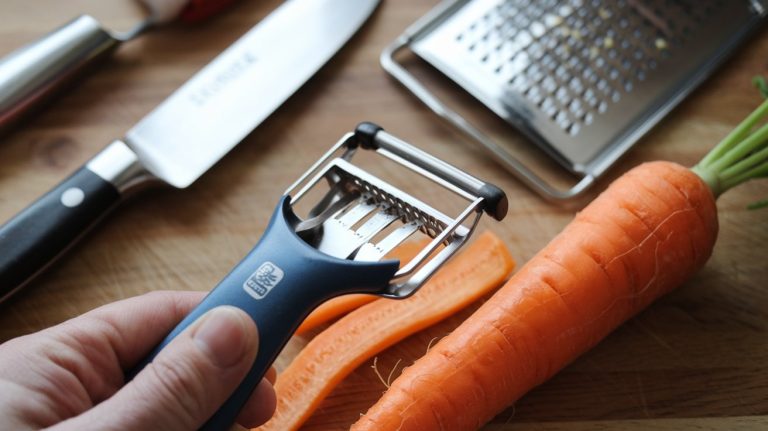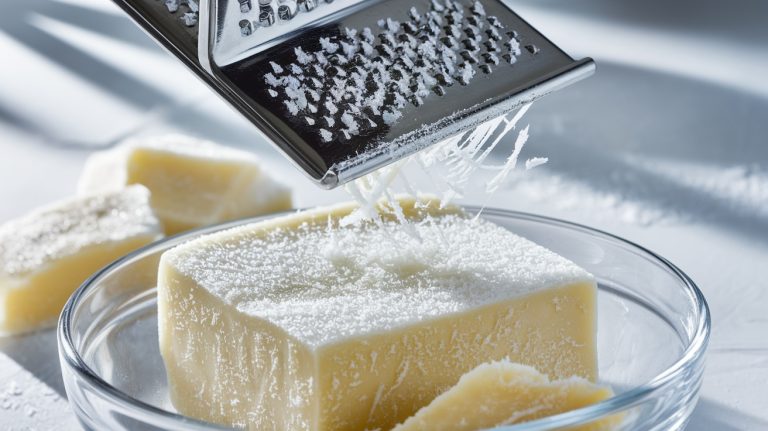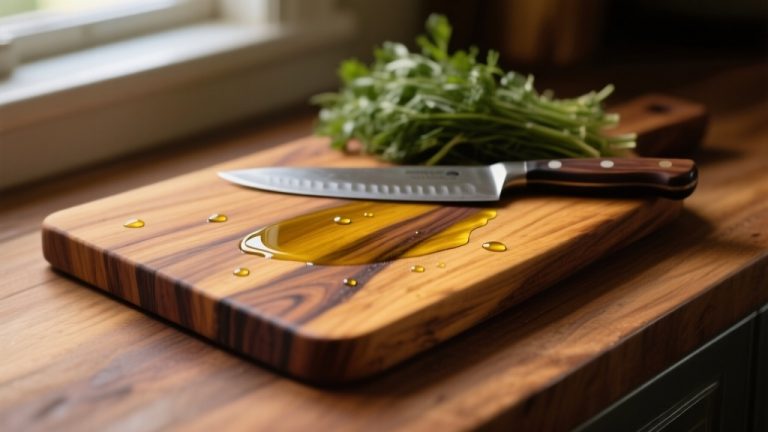Boardsmith vs Boos: The Battle of Cutting Boards
When comparing Boardsmith and John Boos cutting boards, you’ll see distinct differences in quality and craftsmanship.
Boardsmith offers premium hardwoods with end-grain construction for enhanced durability, while Boos provides budget-friendly options but may lack the same level of artistry. Boardsmith allows for customization and emphasizes long-term value with a focus on maintenance.
If you’re weighing premium craftsmanship against affordability, exploring each brand’s features and customer feedback will help you make an informed decision.
Key Takeaways
- Boardsmith focuses on premium craftsmanship and high-quality materials, while John Boos offers more affordable options with variable wood quality.
- Boardsmith’s end-grain construction enhances durability and knife-friendliness compared to Boos’ standard designs that may lack similar features.
- Customization options, including size adjustments and personalized engraving, are available with Boardsmith, whereas Boos has limited customization.
- Boardsmith boards require less initial maintenance and come fully oiled and waxed, while Boos boards may need more upkeep.
- Customer satisfaction is generally higher for Boardsmith due to exceptional craftsmanship and durability, despite its higher price point.
Quality of Materials and Craftsmanship
When choosing between Boardsmith and John Boos, it’s essential to evaluate the quality of materials and craftsmanship that each brand offers.
Boardsmith mainly uses high-quality hardwoods like maple, emphasizing durability through its end-grain construction.
This design not only resists knife marks but also contributes to a longer lifespan. Additionally, the proper maintenance of butcher blocks can significantly enhance their longevity and appearance.
In contrast, while John Boos also utilizes hardwoods, reports suggest some variability in wood quality. Though they do offer end-grain options, they’re not as frequently highlighted. Additionally, some users have replaced Boos boards due to quality concerns, indicating a preference for more reliable materials.
Boardsmith provides larger board sizes, catering to extensive meal prep, whereas Boos tends to have smaller dimensions.
Cost and Affordability Comparison
When considering price accessibility, Boardsmith generally starts at a higher price point compared to Boos, which may influence your decision based on budget constraints.
However, the value per quality is significant; both brands offer durable options that justify their costs over time. Evaluating the specific features and materials can help you determine which brand aligns better with your financial and quality expectations.
For instance, Maple End Grain Cutting Boards from Boardsmith begin at $230, showcasing a premium option in their lineup.
Price Accessibility
Price accessibility is a crucial factor to take into account when comparing Boardsmith and John Boos cutting boards, particularly for consumers with varying budgets.
Boardsmith’s prices generally range from $230 for a Maple End Grain to $410 for a Mosaic End Grain, reflecting its premium craftsmanship and sustainable sourcing.
In contrast, John Boos offers comparable models starting around $200, making it slightly more accessible for budget-conscious buyers. Quality wooden boards tend to be more expensive, but well-made boards can withstand frequent use over time.
Both brands provide standard and custom options, which can influence pricing. While Boardsmith may appeal to premium buyers with its high-end offerings, John Boos presents a more affordable entry point, catering to those seeking quality without breaking the bank.
Additionally, both brands are known for their sustainable sourcing practices, which helps minimize environmental impact.
Value Per Quality
Evaluating the value per quality of Boardsmith and John Boos cutting boards reveals significant differences that can impact your buying decision.
Boardsmith boards, typically over $240, feature premium-grade maple and handcrafted construction, ensuring longevity and durability. Their end-grain design provides a knife-friendly surface, while options for custom features enhance functionality.
The aesthetic appeal of these boards also makes them suitable for display. Additionally, Boardsmith boards often exhibit artisan quality that ensures a superior finish and better overall craftsmanship.
In contrast, Boos boards, while generally more affordable, may not offer the same level of craftsmanship or unique design. Investing in a Boardsmith board can lead to long-term savings due to its durability, potentially retaining value if resold.
Product Features and Customization Options
When comparing Boardsmith and Boos, you’ll find distinct differences in material variety and customization options.
Boardsmith offers a broader selection of wood types and allows for personalized size adjustments at no extra charge, enhancing your ability to create a unique cutting board.
Additionally, Boardsmith allows personalization of every detail of the GMMK 3 keyboard, providing an extensive range of customization that may cater to tech enthusiasts as well.
In contrast, Boos lacks the same level of customization, which may influence your decision based on your specific needs.
Material Variety Offered
While both The Boardsmith and Boos offer a range of hardwood options for cutting boards, the specific materials and construction techniques can greatly impact your choice.
Here’s a breakdown of what each brand provides:
- Material Types: The Boardsmith uses hard maple, black walnut, and black cherry, while Boos features similar options.
- Wood Characteristics: The Boardsmith’s hard maple is known for its tight grain and durability, ideal for cutting surfaces.
- Sustainability: The Boardsmith sources its maple sustainably, holding FSC certification.
- Construction Techniques: The Boardsmith specializes in end-grain boards, which enhance durability and minimize wear. This unique ‘Carolina slab’ pattern not only adds aesthetic appeal but also contributes to the board’s longevity and performance.
Customization Possibilities Explored
Understanding the material options available is just the beginning when considering a cutting board or keyboard purchase.
With Glorious Boardsmith, you can customize every aspect of your keyboard, from frame color to switch technology, boasting over 1 billion configurations. You’ll appreciate the online builder tool, giving you a hands-on design experience.
In contrast, The Boardsmith specializes in wood cutting boards, offering personalized engraving options like monograms on durable maple or walnut. Their boards are crafted from high-quality wood species, ensuring durability and longevity for everyday kitchen use.
While Glorious focuses on aesthetic lighting and knob customization, The Boardsmith emphasizes craftsmanship and functionality in kitchen use.
Size Options Comparison
Choosing the right size for your cutting board can considerably impact your kitchen experience, as different brands offer varying dimensions and thicknesses tailored to specific needs.
When comparing Boardsmith and John Boos, consider the following size options:
- Boardsmith Sizes: 12 x 18, 16 x 22, and 18 x 24 inches.
- John Boos Sizes: Commonly available in 20 x 15 inches for end-grain maple boards.
- Thickness: Boardsmith generally measures 2 inches, while John Boos typically ranges from 1.5 to 2 inches.
- Custom Orders: Both brands allow for tailored sizing to meet your requirements. Additionally, finger grooves are a cost-effective option that many customers choose for added convenience when handling their butcher blocks.
Maintenance and Care Requirements
Maintaining the longevity and functionality of your cutting board requires consistent care and attention to detail. Both Boardsmith and Boos boards need regular oiling with mineral oil to prevent cracking and keep the wood healthy.
Boardsmith offers Board Butter, enhancing protection and water resistance. Regular care ensures the butcher block’s quality by preventing damage and extending its lifespan. Additionally, applying food-safe sealants can significantly enhance the board’s durability against moisture and bacteria.
| Action | Frequency |
|---|---|
| Oil application | Weekly (first month) |
| Clean and dry | After each use |
| Oiling unused boards | Every 30 days |
Be sure to apply oil on both sides for even absorption and buff excess oil properly. Avoid vegetable oils and never leave boards in standing water.
Customer Feedback and Market Presence
Customer feedback plays a significant role in shaping the reputation of both Boardsmith and Boos in the competitive cutting board market. Here’s how customer experiences and market presence differ:
- Durability & Quality: Boardsmith cutting boards are often praised for their exceptional craftsmanship, leading to strong customer loyalty.
- Customer Service: While many report excellent communication from Boardsmith, some experience issues with website functionality and customer service, particularly when encountering frustrating issues during the purchase process.
- Brand Recognition: Boardsmith garners endorsements from notable publications like Serious Eats, enhancing its market presence.
- Market Trends: The demand for artisanal cutting boards favors Boardsmith, appealing to consumers who prioritize both durability and aesthetics.
Design and Functionality Differences
While both Boardsmith and Boos offer high-quality cutting boards, their design and functionality cater to different preferences and needs.
Boardsmith boards are fully oiled and waxed, providing a handcrafted aesthetic, while Boos boards feature durable hardwood options like maple and cherry.
You’ll find that Boardsmith allows for customizable sizes, typically larger at 22″ x 16″, while Boos offers various models, usually around 20″ x 15″. Regarding stability, Boardsmith boards come with feet, enhancing usability, whereas Boos focuses on specialized features like juice grooves.
Boardsmith offers a handcrafted touch with fully oiled and waxed boards, while Boos showcases durable hardwood like maple and cherry.
Maintenance varies too; Boardsmith requires occasional re-oiling, while Boos recommends monthly care, including products like Boos Block Cream.
Final Thoughts on Boardsmith and Boos
When reflecting on the choice between Boardsmith and Boos, it’s essential to weigh their distinct qualities and how they align with your personal preferences. Here are some key points to contemplate:
- Quality: Boardsmith offers artisan craftsmanship with a superior finish, while Boos provides affordability but may compromise on quality.
- Maintenance: Boardsmith boards come fully prepared, requiring less initial upkeep compared to Boos, which requires regular oiling. Additionally, food safety is a significant consideration when choosing between the two brands, as both prioritize hygiene in their designs.
- Durability: Boardsmith’s materials enhance longevity, while Boos boards have reported issues like cupping or splitting.
- Customer Experience: Boardsmith users often cite better service and unique touches, whereas Boos is more accessible but less personalized.
Frequently Asked Questions
Are Boardsmith Boards Eco-Friendly and Sustainably Sourced?
Yes, Boardsmith boards are eco-friendly and sustainably sourced. They use FSC-certified hardwoods, ensuring responsible harvesting practices.
By sourcing lumber from a local family sawmill in Pennsylvania, you support sustainable supply chains and reduce transportation-related carbon footprints.
Each board’s handcrafted nature emphasizes durability, minimizing waste and the need for replacements.
With a focus on quality and sustainability, choosing Boardsmith reflects a commitment to environmentally conscious purchasing decisions while enjoying premium craftsmanship.
How Long Does It Take to Receive a Custom Boardsmith Order?
You’d think getting a custom order would be a quick fix, but with Boardsmith, it takes about 7-8 weeks.
Each board is meticulously handmade, which explains the wait.
Shipping times might vary based on demand, but rest assured, your order is crafted with care.
Enjoy free shipping on orders over $200, and know that your purchase is protected by Route Shipping Insurance, covering loss or damage during transit.
Patience does pay off!
Can I Return a Boardsmith or Boos Product if Unsatisfied?
Yes, you can return a Boardsmith product if you’re unsatisfied, as long as it’s within the 60-day return window and in its original condition.
For Boos products, return policies aren’t clearly outlined, so it may depend on the specific retailer.
If you’re considering a return, check the conditions for each brand, as quality assurance plays a significant role in their customer policies.
Always reach out to customer support for guidance.
What Warranty Options Are Available for Boardsmith and Boos Boards?
You might think warranties are just fancy promises, but they actually protect your investment.
Boardsmith offers a 60-day warranty against defects, but misuse or improper care can void it.
On the other hand, you won’t find specific warranty details for Boos boards in the sources.
Understanding these options helps you make an informed choice, ensuring you care for your cutting board properly to keep that warranty intact.
Don’t let improper cleaning ruin your coverage!
Do Boardsmith and Boos Offer International Shipping?
Yes, both companies offer international shipping, but specifics vary.
Boardsmith clearly states that customers are responsible for taxes, tariffs, and VAT, and they provide insurance for orders. They also have a made-to-order process that may take several weeks.
On the other hand, detailed information about Boos’ international shipping isn’t readily available, so contacting them directly for specifics is essential.
Generally, you should expect to handle import fees when shipping internationally with either company.
The Right Fit for Your Kitchen: A Final Look at Boardsmith and Boos
In comparing Boardsmith and Boos, it’s clear both brands offer exceptional quality and craftsmanship. However, Boardsmith’s customization options and unique designs may appeal more to those seeking individuality, while Boos remains a trusted choice for classic functionality.
Think of it like choosing between a vintage vinyl record and a digital playlist; both deliver great sound, but your preference for style and substance will ultimately guide your decision. Evaluate your needs carefully to make the best choice for your kitchen.
